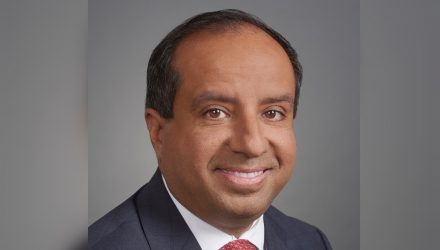In yet another point in active investing’s corner, the Fidelity Blue Chip Growth (FBCG) ETF looks set to conclude 2023 as one of the top five active ETFs with at least $300 million in AUM when ranked by YTD performance. Specifically, FBCG has returned 57.93% YTD as of December 21st per YCharts. The strategy is nearing $1 billion in AUM. As such, it may be worth hearing from one of FBCG’s managers, Sonu Kalra, about blue chip investing itself.
See more: “Sitting Down With Fidelity Investments’ Quant Head, Neil Constable“
Kalra, who together has managed the ETF alongside Michael Kim since 2020, has worked at Fidelity Investments since 1998. Kalra shared his thoughts on the Blue Chip Growth strategy’s overall approach. This was part of a broader series of interviews celebrating the release of the firm’s Japan edition of FBCG. With investors browsing the burgeoning ETF landscape ahead of 2024, now may be an opportune time to hear his thoughts.
“My investment philosophy sits in the view that the market often underestimates the durability or sustainability of growth. I believe bottom-up fundamental analysis is the best way to identify these blue chip business models,” Kalra said. He also noted that he leans on the firms’ research team to bolster his work with FBCG.
“Of particular interest are companies with exposure to secular tailwinds and business models that can capture a growing share of large addressable markets,” he added.
FBCG right now holds big names from the so-called “Magnificent Seven.” These are the funds that have lifted the markets significantly this year. On top of names like Nvidia (NVDA) and Apple (AAPL), however, it also holds firms like NXP Semiconductors (NXPI) and Lowe’s Companies (LOW). Those don’t always appear in other growth strategies with wide remits.
Kalra expanded on his views on FBCG’s approach. He defined blue chip firms as those that possess “a sustainable business model, high and/or improving returns on equity, and above-average revenue and earnings growth characteristics.”
“Quantitatively, we are aiming to invest in companies that can consistently achieve +10% EPS growth on an annual basis,” he said. “Some portfolio holdings are mega-cap companies with recognizable brand names. Others are smaller emerging growers that have not yet become widely appreciated by the market.”
So, then, what is the blue chip growth ETF’s outlook? The strategy has done well YTD with its active approach. Hitting its three-year mark this past June, its blue chip investment that may be mispriced by the market has yielded results.
The Approach for 2024
For 2024, however, an active approach could continue to do well. That would be thanks to its adaptability and seasoned management by people like Kalra. With global markets facing geopolitical, inflationary, and other types of risks, a blue chip growth ETF and its fundamental analysis can appeal.
“Macro-economic headwinds remain in place. Namely interest rates and inflation remain concerns, which consumers feel especially acutely when the price of gasoline increases,” Kalra said. “Despite these cyclical headwinds, I remain bullish on the long-term return potential of U.S. stocks. That especially applies to parts of the market that can profit from secular growth trends like Artificial Intelligence.”
For more news, information, and strategy, visit the ETF Investing Channel.
Fidelity Investments® is an independent company, unaffiliated with VettaFi. There is no form of legal partnership, agency affiliation, or similar relationship between VettaFi and Fidelity Investments, nor is such a relationship created or implied by the information herein. Fidelity Investments has not been involved with the preparation of the content supplied by VettaFi and does not guarantee, or assume any responsibility for its content.
1126253.1

